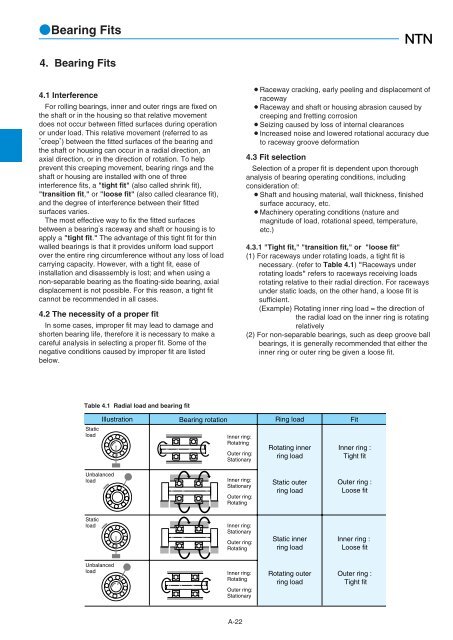NTN - Large Bearings
Create successful ePaper yourself
Turn your PDF publications into a flip-book with our unique Google optimized e-Paper software.
Bearing Fits<br />
4. Bearing Fits<br />
4.1 Interference<br />
For rolling bearings, inner and outer rings are fixed on<br />
the shaft or in the housing so that relative movement<br />
does not occur between fitted surfaces during operation<br />
or under load. This relative movement (referred to as<br />
creep) between the fitted surfaces of the bearing and<br />
the shaft or housing can occur in a radial direction, an<br />
axial direction, or in the direction of rotation. To help<br />
prevent this creeping movement, bearing rings and the<br />
shaft or housing are installed with one of three<br />
interference fits, a "tight fit" (also called shrink fit),<br />
"transition fit," or "loose fit" (also called clearance fit),<br />
and the degree of interference between their fitted<br />
surfaces varies.<br />
The most effective way to fix the fitted surfaces<br />
between a bearings raceway and shaft or housing is to<br />
apply a "tight fit." The advantage of this tight fit for thin<br />
walled bearings is that it provides uniform load support<br />
over the entire ring circumference without any loss of load<br />
carrying capacity. However, with a tight fit, ease of<br />
installation and disassembly is lost; and when using a<br />
non-separable bearing as the floating-side bearing, axial<br />
displacement is not possible. For this reason, a tight fit<br />
cannot be recommended in all cases.<br />
4.2 The necessity of a proper fit<br />
In some cases, improper fit may lead to damage and<br />
shorten bearing life, therefore it is necessary to make a<br />
careful analysis in selecting a proper fit. Some of the<br />
negative conditions caused by improper fit are listed<br />
below.<br />
¡Raceway cracking, early peeling and displacement of<br />
raceway<br />
¡Raceway and shaft or housing abrasion caused by<br />
creeping and fretting corrosion<br />
¡Seizing caused by loss of internal clearances<br />
¡Increased noise and lowered rotational accuracy due<br />
to raceway groove deformation<br />
4.3 Fit selection<br />
Selection of a proper fit is dependent upon thorough<br />
analysis of bearing operating conditions, including<br />
consideration of:<br />
¡Shaft and housing material, wall thickness, finished<br />
surface accuracy, etc.<br />
¡Machinery operating conditions (nature and<br />
magnitude of load, rotational speed, temperature,<br />
etc.)<br />
4.3.1 "Tight fit," "transition fit," or "loose fit"<br />
(1) For raceways under rotating loads, a tight fit is<br />
necessary. (refer to Table 4.1) "Raceways under<br />
rotating loads" refers to raceways receiving loads<br />
rotating relative to their radial direction. For raceways<br />
under static loads, on the other hand, a loose fit is<br />
sufficient.<br />
(Example) Rotating inner ring load = the direction of<br />
the radial load on the inner ring is rotating<br />
relatively<br />
(2) For non-separable bearings, such as deep groove ball<br />
bearings, it is generally recommended that either the<br />
inner ring or outer ring be given a loose fit.<br />
Table 4.1 Radial load and bearing fit<br />
Static<br />
load<br />
Illustration Bearing rotation<br />
Ring load Fit<br />
Inner ring:<br />
Rotatring<br />
Outer ring:<br />
Stationary<br />
Rotating inner<br />
ring load<br />
Inner ring :<br />
Tight fit<br />
Unbalanced<br />
load<br />
Inner ring:<br />
Stationary<br />
Outer ring:<br />
Rotating<br />
Static outer<br />
ring load<br />
Outer ring :<br />
Loose fit<br />
Static<br />
load<br />
Inner ring:<br />
Stationary<br />
Outer ring:<br />
Rotating<br />
Static inner<br />
ring load<br />
Inner ring :<br />
Loose fit<br />
Unbalanced<br />
load<br />
Inner ring:<br />
Rotating<br />
Outer ring:<br />
Stationary<br />
Rotating outer<br />
ring load<br />
Outer ring :<br />
Tight fit<br />
A-22

















